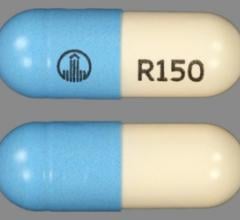
A slide image from Reddy's presntation at Heart Rhythm 2018, showing thrombus formation on the face of a Watchman device in an echo image.
May 18, 2018 — Left atrial appendage closure (LAAC) with the transcatheter Watchman device prevents thromboembolism from the LAA, but a new study shows that thrombus forms on the face of the device in about 3.7 percent of patients and it can embolize. The study was presented at Heart Rhythm 2018, the Heart Rhythm Society’s 39th Annual Scientific Sessions.
While not frequent, when present, thrombus on the face of an LAA occluder is associated with a high rate of ischemic stroke, said study presenter Vivek Y. Reddy, M.D., from the Icahn School of Medicine at Mount Sinai, New York. To better understand the mechanism of stroke after LAAC, he said the study looked at the incidence, predictors and clinical outcomes of device-related thrombus (DRT).
Researchers studied the device arms of four prospective FDA trials: PROTECT-AF n=463; PREVAIL n=269; CAP n=566; and CAP2 n=579. Surveillance transesophageal echos (TEE) were required at 45 days and 12 months. Researchers assessed both the incidence of DRT during these TEEs (plus other unscheduled TEEs) and clinical outcomes, both post-procedure stroke or systemic embolization.
Of the cohort with successful implantation (1,739 patients; 7,159 patient-years FU; CHADS-VASc = 4.0), DRT was four Heart Rhythm 2018 seen in 65 pts (3.74%). The annual rates of systemic embolization without and with DRT were 1.78% and 7.46% (RR 3.55, 95% CI 2.18 – 5.79; p < 0.0001), ischemic systemic embolization rates were 1.65% and 6.28% (RR 3.22, 95% CI 1.90 - 5.45; p < 0.0001; Fig 1). On multivariate logistic regression analysis, DRT was predicted by: permanent AF – OR 2.5, p=0.0004; LVEF – OR 0.97 p=0.02; CHADS-VASc score – OR 1.25, p=0.0075; LAA diameter – OR 1.05, p=0.046). DRT and systemic embolization both occurred in 17 of 65 patients (26.2%); temporal analysis suggests a causal relationship between DRT and systemic embolization in 12 of 17 patients (70%; Fig 2). Conversely, after LAAC, most systemic embolization (123 of 142, 87%) occurred in patients without DRT.
Reddy said future efforts should be made to minimize DRT to further improve the efficacy of LAAC.
Related LAA Watchman Occluder Content:
VIDEO: New Data on LAA Occlusion From the PREVAIL and PROTECT Trials — interview with Vivek Reddy, M.D.
Occluding the Left Atrial Appendage (LAA)
VIDEO: Post-FDA Approval Experience of LAA Occluders — interview with David Holmes, M.D.
Four-Year Data Shows Watchman Device Superior to Warfarin in Afib patients
Find links to all the Heart Rhythm 2018 Late-breaking Studies
#HRS2018 #HRS18


 August 28, 2023
August 28, 2023 








